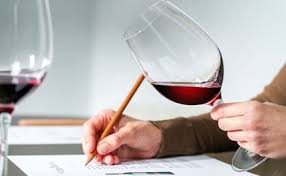by Dwight Furrow
 Last month I argued that wine tasting notes don’t give us much information about how a wine tastes. Most tasting notes consist of a list of aromas that are typical for the kind of wine being described. But we can’t infer much about quality or distinctiveness from a list of typical aromas. Whether a Cabernet Sauvignon shows black cherry or blackberry just isn’t very important for one’s enjoyment. The basic problem with this approach to describing wine is that a list of individual elements does not reveal how these elements interact to form a whole. We get pleasure from a wine because the elements—aromas, flavors, and textures—form complex relations that we taste as a unity. But our wine vocabulary does a poor job of describing that unity.
Last month I argued that wine tasting notes don’t give us much information about how a wine tastes. Most tasting notes consist of a list of aromas that are typical for the kind of wine being described. But we can’t infer much about quality or distinctiveness from a list of typical aromas. Whether a Cabernet Sauvignon shows black cherry or blackberry just isn’t very important for one’s enjoyment. The basic problem with this approach to describing wine is that a list of individual elements does not reveal how these elements interact to form a whole. We get pleasure from a wine because the elements—aromas, flavors, and textures—form complex relations that we taste as a unity. But our wine vocabulary does a poor job of describing that unity.
This unhelpful approach to tasting notes has a history. Aromas are caused by compounds in wine that can be objectively determined. Thus, there are well-established causal relationships between compounds objectively “in the wine” and the subjective impressions of well-trained tasters that enable standards of correctness to be applied to wine tasting. These standards provide the wine community with a definable, teachable skill grounded in facts about wine. The development of that skill and the standards of correctness that enable it is a worthy goal, but this tasting model leaves the aesthetic experience of wine out of the picture.
What then is the alternative? Read more »
